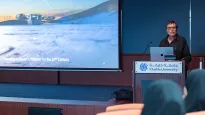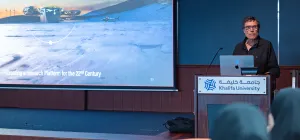Jacques Richon on the New Medical Facilities at Princess Elisabeth Antarctica

Swiss doctor Jacques Richon spent twelve seasons at the Princess Elisabeth Antarctica from 2008 to 2021 as the station’s Chief Medical Officer. His decades of experience working as a surgeon, an emergency doctor carrying out helicopter rescues in the Alps, and a renowned mountain guide for extreme environments was a major asset to the teams he accompanied to the station. In his last interview with IPF, he talks about the work he did to improve the medical facilities at the Princes Elisabeth Antarctica, (PEA) and future plans he had for the station.
On Friday 19th March, Jacques Richon lost his life in an avalanche in the Swiss canton of Valais. The BELARE team, IPF and all his myriad friends are devastated by this terrible event. Dr Jack died as he lived, at full throttle. A very hard act to follow. We are impoverished by his absence and eternally in his debt for all he did to keep operations at Princess Elisabeth safe for all expeditioners.
What initiatives did you take to improve PEA’s medical facilities over the years?
I was the on-site doctor when the Princess Elisabeth Antarctica Station was being built during the 2007-2008 and 2008-2009 seasons. The station wasn’t finished yet during those first two seasons. We were living in tents until the main building of the station had been constructed, so medical facilities back then were very rudimentary - basically a red container called the “Swiss Hospital” - which was kitted out with examination bed, a window, a door, some shelving, and counters for the medical equipment and supplies.
As the station neared completion, we opened a small medical office in the main building. Despite space restrictions, we were able to fit an examination bed and monitoring equipment in the space. We had enough equipment to stabilise a seriously injured patient until a medical evacuation was possible. These past few years we began to concentrate on providing better medical facilities, particularly with regard to diagnostics as the costs of these technologies have decreased over time.
Three or four years ago, when we started to rebuild the station’s annexes, Alain had the idea of adding a new surgery room in case a more serious medical intervention might be required at some point. The construction team installed walls, heating, electricity, and lights, and then last year, we added medical fittings and furniture designed to be as ergonomic as possible.
The new surgery room is upstairs in the South Annex, so in case of emergency, we can access it from the outside using a stair ramp.
What improvements did you make during the last season (2020-21)?
During this past season, despite the COVID pandemic restricting operations, we managed to install the remaining furniture in the surgery room, including a fully mechanical operating table, which, as it’s not electric, can easily be repaired in case of damage. We also painted the room with a clear, washable bactericidal paint, making the room easier to disinfect. With no window in the room, having white-coloured walls makes the room feel brighter.
The new surgery room is very well-equipped. We’ve got surveillance equipment, oxygen, a defibrillator, medication, and surgical equipment for the eventual interventions. We can also administer local anaesthesia (for general anaesthesia, we would need someone on hand who has the qualifications and certification for this).
Will you still use the medical office in the main building of the station?
The medical office will still serve as a place where station residents can have a general medical consultation. The new surgery room will be used specifically for more severe injuries, reanimation, and surgical interventions.
Have you ever considered having more than one doctor at the station at a time?
There aren’t many of us at the station, and having two doctors simultaneously would be a big cost. Over the years, we’ve had very few serious injuries. Thankfully we’ve never had a very serious case that required a medical evacuation. So it makes sense to have only one doctor on-site. However, we frequently have additional personnel with paramedical skills on the staff. Most of the time there is no work for the Medical staff and you help with other tasks at the station.
How did you handle the Covid-19 situation?
Dr. Martin Leitl was the station’s doctor for the first weeks of the most recent season. I relieved him in mid-December. IPF bought a PCR test machine and Martin took care of testing everyone during the quarantine in South Africa and also at the Station. It worked out very well and no one contracted the virus. GG had established the DROMLAN medical protocols to contain the risk of infection and transmission.
Even though everyone who came to the station had to follow very strict quarantine before leaving for Antarctica and were tested several times before leaving, we made absolutely sure that no-one at the station was infected with Covid at any time. Everyone was able to live at the station over the four months of the season without any worries.
Do you have other tasks apart from handling medical consultations while you’re at the station?
I’m not much of a carpenter or technician myself. This last season, in addition to painting the new surgery room, I helped the cook prepare meals every day. During previous seasons, I regularly worked as a guide and accompanied scientists in the field. We also organized field rescue simulations to train the personnel in case of an emergency in the field.
What are your future plans for medical facilities at the PE station now that the operating room has been completed?
Next season we hope to add a few more things to the surgery room such as a sink with running water. In the coming years, we had the idea that if there ever were a big medical emergency, it would be a good idea to have a room to monitor a patient. In the coming years we could free up a room next to the surgery room where we could put two beds, e.g. for a quarantine or a recovery room. One bed could be used for a patient and the other for the person providing the medical support. We also had the idea of one day installing a new medical laboratory, but this isn’t a priority at the moment. There is an existing wet lab shared with the water management team, but it is getting a bit crowded of late.
Between seasons, I’ve been working on updating the station’s medical plan and making a doctor’s mission statement so that IPF management are fully aware of all health risks at the station. The Belgian/Swiss collaboration between the hospital in Sion, Switzerland and IPF allows us to provide doctors for the missions in Antarctica. As part of this contract, I’ve been asked to consult with various specialists.
I’m also interested in further developing telemedicine capabilities at the station. We have a privileged contact with the emergency room staff at the hospital in Sion. We could connect with them using our satellite link via Skype or Zoom, which would allow us to share information such as patient scans and ultrasounds with specialists at the hospital.
Do you think you will continue to go on expeditions over the next few years?
My goal is to find a highly skilled replacement. I’m not getting any younger. We need someone who has the right skills in surgery and in administering anaesthesia. I’ll have to consult with Alain because there are a lot of qualified candidates for the position now. I hope to be able to train someone who will take over my position one day.
Download





















